A history of Technic panels, part 1
Posted by Huw,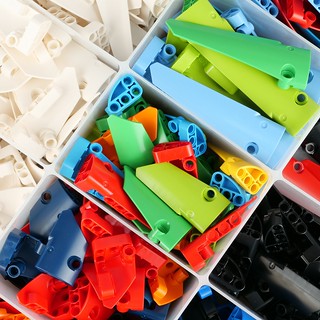
Technic panels first made an appearance in 1999. Prior to their introduction, Technic sets typically had a skeletal appearance which exposed their innards. The curves of vehicles' bodywork were implied through the use of hoses and flex tubes as typified by 1998's 8432 Concept Car.
Panels provide a means to create more substantial and convincing bodies for models, although the first iteration was far too abstract to do so effectively.
In this article I'll examine the three types of 'wing-shaped' ones before turning my attention to the curved and flat panels in the next part.
Type 1: 1999-2009
The first panels were introduced in four second half of year 1999 sets, in two sizes. They had four mounting holes on the end and two larger holes running lengthwise into which hoses could be inserted. 8446 Crane Truck is a good example of doing this to extend the lines of the bodywork.
In 2000 and 2001 two smaller sizes were introduced. To enable left- and right-hand versions and the different sizes to be differentiated easily they have numbers moulded into them which are indicated in the instructions.
There are the four sizes, numbered 1 to 8:
#1 & #2: Large short (1999-2004)
32190 3D Panel 6M-1 / 32191 3D Panel 6M-2
These were used in 22 sets between 1999 and 2001. They were produced in 13 colours, including a ghastly metallic green in 8466 4x4 Off-Roader and metallic silver in 2000's flagship set 8458 Silver Champion.
#3 & #4: Large long (1999-2005)
32188 3D Panel 12M-3 / 32189 3D Panel 12M-4
This one had a slightly longer lifespan, until 2003. It appeared in 13 sets in 8 colours.
#5 & #6: Small short (2000-2009)
32527 3D-Panel 5M-5 / 32528 3D-Panel 5M-6
The smallest of the first iteration of panels was introduced in 8516 Super RoboRider in 2000 before finding more widespread use in Technic sets the following year.
It was included in 53 sets and was produced in 18 colours. It continued to be used until 2009 despite the second iteration of panels largely superseding the first in 2002.
#7 & #8: Small long (2001-2008)
32534 3D-Panel 10M-7 / 32535 3D-Panel 10M-8
The last of the first version panels was introduced in 2001 and remained in the parts palette until 2008. It was used extensively in the Star Wars Technic figures -- not entirely successfully -- for torsoes, arms and legs. It was used in 33 sets and produced in 12 colours.
Type 2: 2002-2009
The large holes and crevices of the first iteration of panels allowed hoses to be inserted but looked very ugly and too abstract for many applications. The second design of panels replaced the large hole with a smaller one into which flex rods (example) could be inserted.
Like the earlier panels they have mounting holes at the end only and note how the flex rod hole has been modified to prevent pins being inserted into it. This series of panels was produced in three sizes and numbered 20-25.
#20 & #21: Large long (2002-2008)
44350 3D Panel 12M W.Ø4.85, No. 20 / 44351 3D Panel 12M W. Ø4.85, No. 21
This, and the smaller one below, first showed up in 8461 Williams F1 Team Racer in 2002. They were used extensively in the Racers sets released over the next few years. They were found in 24 sets, in 8 colours.
#22 & #23: Large short (2002-2009)
44352 3D Panel 7M W. Ø4.85, No. 22 / 44353 3D Panel 7M W. Ø4.85 No. 23
27 sets, 9 colours.
#24 & #25: Small short (2004-2007)
47712 3D Panel 5M. Ø4.85 No. 24 / 47713 3D Panel 5M. Ø4.85 No. 25
This short lived piece was used in just 9 sets, all of them Racers, and was produced in blue and red only. Technic sets of the same period still utilised the older small panel for some reason.
Type 3: 2009 onwards
In the summer of 2009 all the panels that went before were swept aside and replaced with a smooth, more versatile design, although it was actually the year before in Bionicle sets such as 8943 Axalara T9 that the first one -- a curved panel that will included in part two of this article -- appeared.
This style has no holes on the flat surface for poking things in, since using flex rods and hoses for bodywork had largely fallen out of favour by 2009, and they can be connected in three planes which make them far more versatile. As a result, models in which they are used are much more aesthetically pleasing.
The panel number series has been reused, starting at #1 again, although there are a lot of gaps, for future expansion of sizes.
There are currently six different sizes of this modern panel, from 2x5 to 5x11:
#1 & #2: 3x5 (2010-date)
87080 Left Panel 3X5 / 87086 Right Panel 3X5
This one first made an appearance in Technic sets in 2010. It's been used in 74 sets in 13 colours.
#3 & #4: 3x7 (2009-date)
64683 Left Panel 3X7 / 64391 Right Panel 3X7
This longer version is included in 80 sets in 14 colours. Like many of the panels, it's common in black, white and red but much less so in others. The bright green one below, for example, only came in 42039 24 Hours Race Car.
#5 & #6: 3x11(2009-date)
64681 Left Panel 3X11 / 64393 Right Panel 3X11
This longest of the 3-high panels has been used in 47 sets, in 13 colours, including unusually, tan, in 8995 Thornatus V9.
#13 & #14: 5x7 (2009-date)
64394 Left Panel 5X7 / 64680 Right Panel 5X7.
This is currently the shortest of the 5-high panels but its numbers, 13 and 14, suggests that numbers 11 and 12 have been reserved for a 5x5 version. It's been used in 29 sets and produced in 10 colours, which makes it the least common of the new panels.
#17 & #18: 5x11 (2009-date)
64392 Left Panel 5X11 / 64682 Right Panel 5X11
Again, a gap in the numbering suggests that we might one day see numbers 15 and 16 on 5x9 panels.
It can be found in 33 sets in 12 colours, one of the rarest being sand blue, in 70656 garmadon, Garmadon, GARMADON!.
#21 & #22: 2x5 (2013-date)
11946 Right Panel 2X5 / 11947 Left Panel 2X5
These tiny panels were introduced 4 years after the first. They were used in most of 2013's Technic assortment so I can't say for certain which one it was designed for but it could well have been 42000 Grand Prix Racer where it's used on the front wing.
Unlike the others it has an axle hole on the end which enables it to be held securely with just one pin.
To date it's been produced in 18 colours, more than any other panel, and used in 72 sets. Several colours have appeared only once, for example 75533 Boba Fett contains them in sand green.
So, no new panels of this type have been introduced for 6 years. Instead LEGO has recently put its efforts into flat and curved ones, which will be the focus of the next part of this article.
If you enjoyed this article, do let me know in the comments. They always seem a bit dry to me when reading them back!
206 likes

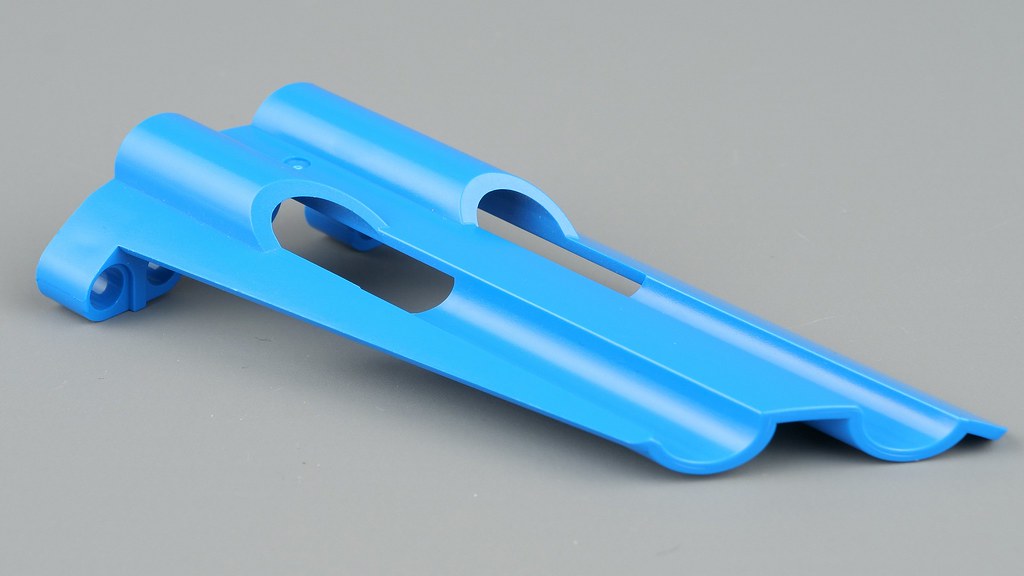
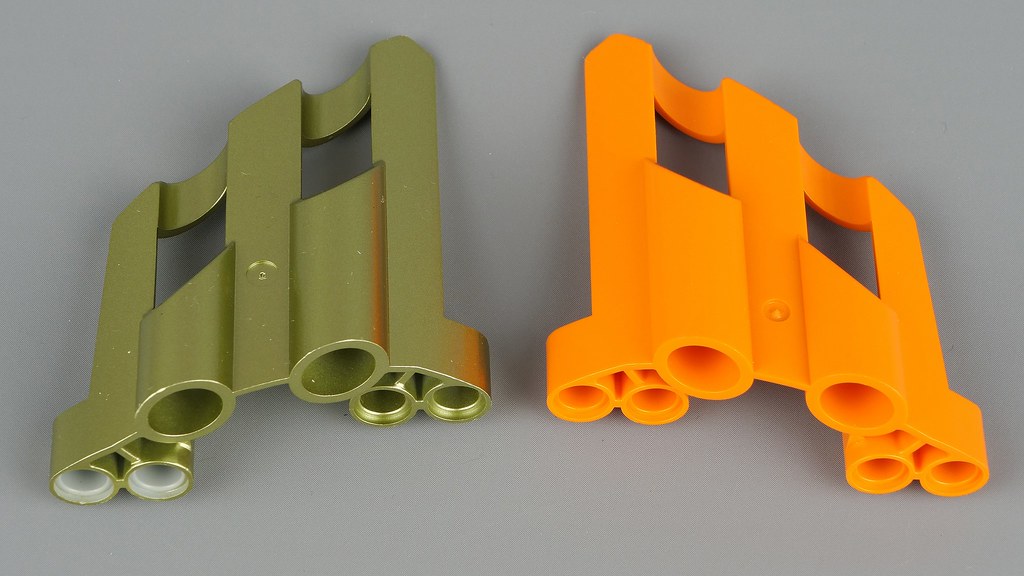






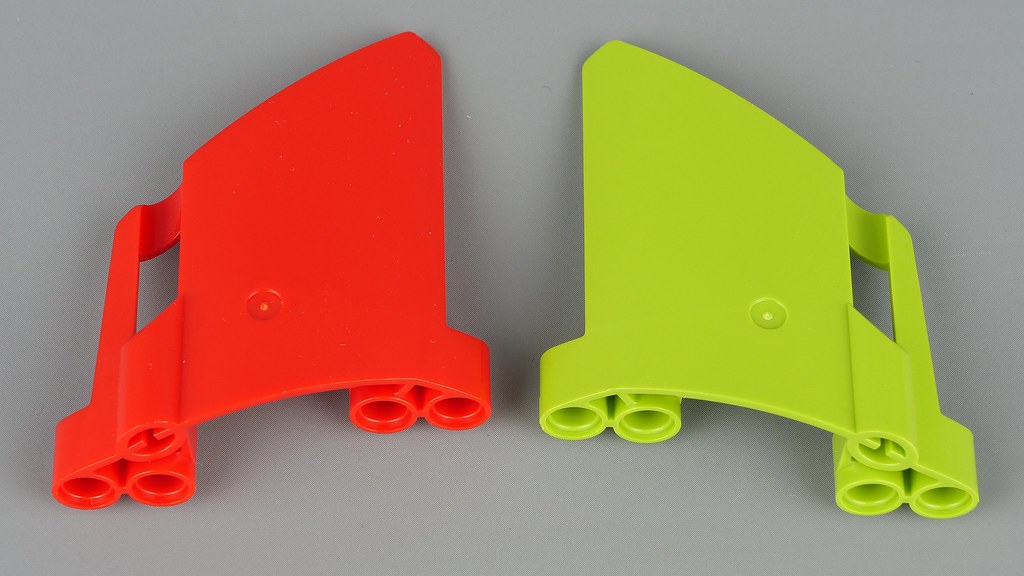



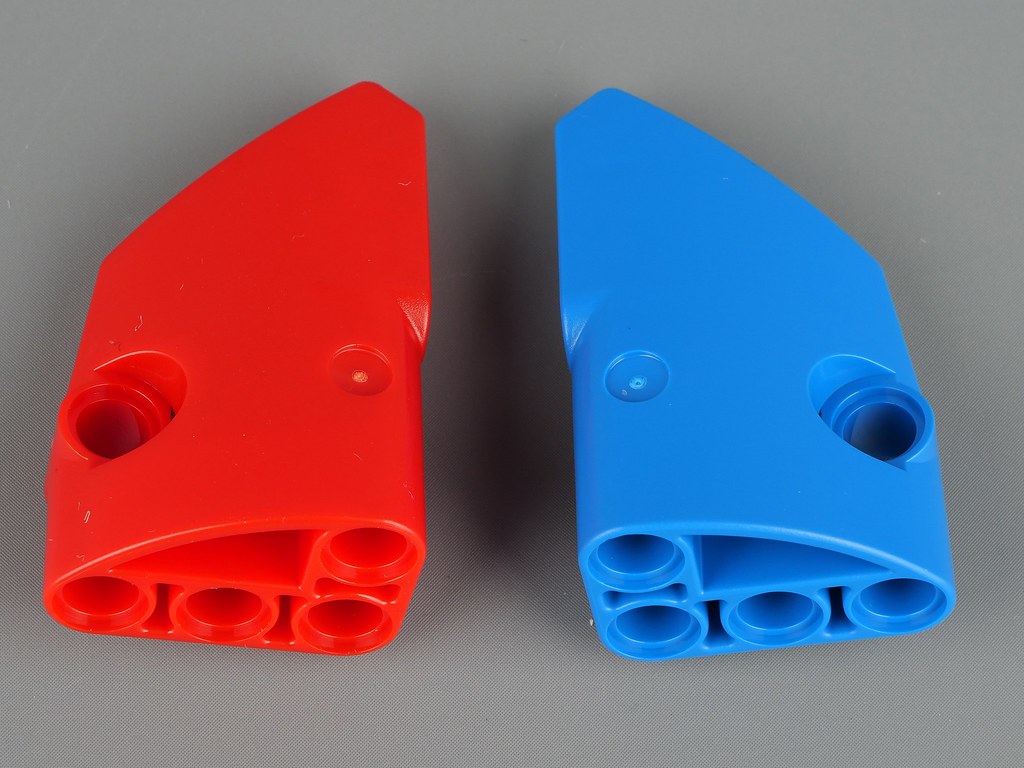
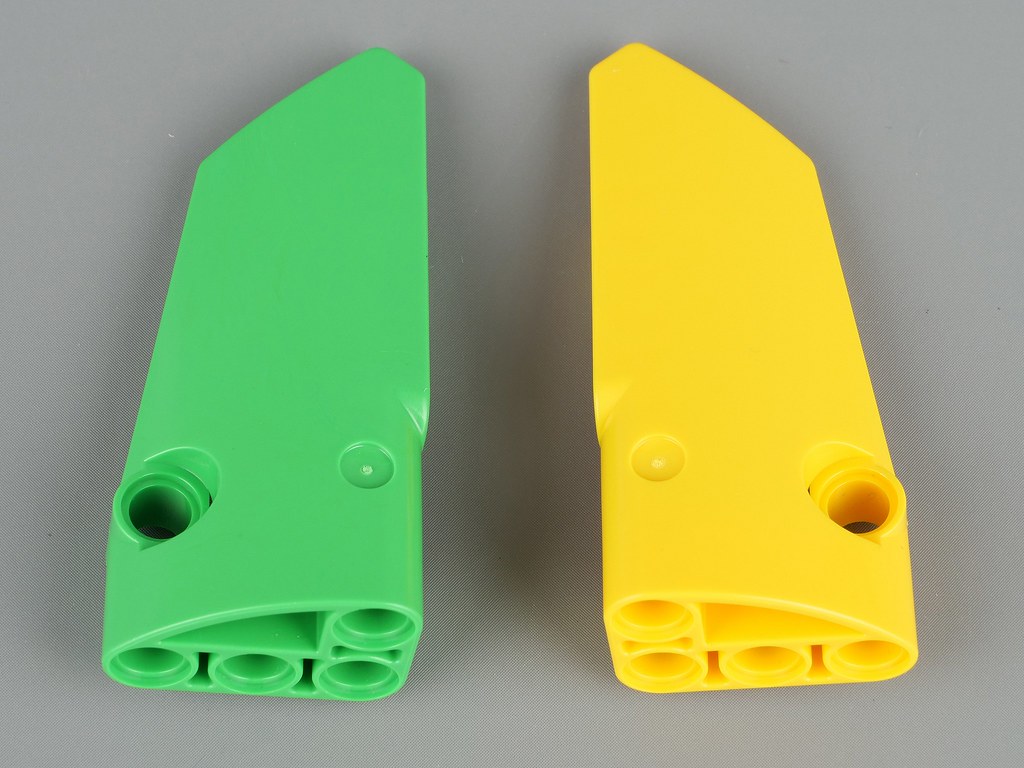
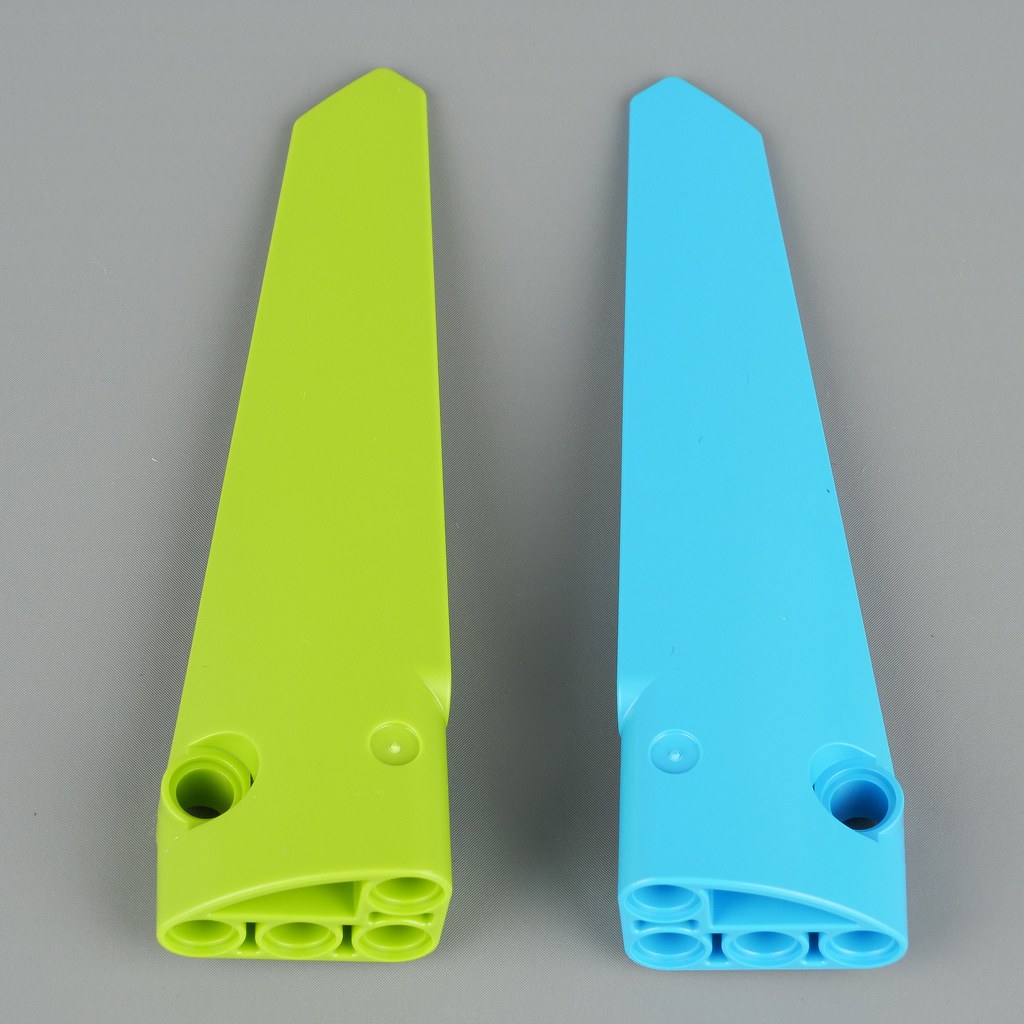



45 comments on this article
Just so you know: not dry; much appreciated.
Another EXCELLENT Technic history article by Huw.
Thanks!!
These history articles are perhaps not the most read, but they are the most liked.
These articles are very different then the reviews and current news type articles but that is part of their appeal. I find your knowledge of Technic history fascinating and thank you for taking the time to put together this article.
I don't really do modern Technic and am always a bit baffled by the range of panels, so this is fantastic, thank you!
I actually really like that metallic green, not gonna lie........
Another great read Huw, thanks... had no idea there was such an array of colours!
There aren't enough of these types of articles. New Elementary has articles about new parts and their connection points, but there comparitively is very little historical information about the development evolution of pieces such as the Technic features we've enjoyed the last few weeks. I've been looking forward to reading these as they are written.
Though its not specifically Technic you should do an article on the progression of Electronic parts; things like light, sound, remotes, etc. Things that led up to the Power Functions and now the new Power Up. I remember (and surprised) reading an article on Brickset where it was mentioned that even back in the 60s Lego had produced Lights or sets that moved by sound; and here I though in the late 70s and early 80s when I could have (a somewhat) remote car and space sets with lights and sounds was pretty advance for Lego.
I know I can go look them up, but it would be interesting to see a picture giving an example of panel in use alongside each type.
Don't hate on the metallic green!
I acknowledge this kind of articles might not be to everyone's tastes, but as a Technic fan I love them, please keep'em coming!
@MrJackson It's not as in-depth as these articles, but you can see a history of Technic elements in the years pages at http://technicopedia.com/
@AVCampos well, there goes my productivity today.....
Excellent article! Always love reading about this type of stuff.
Just one thing though: "ghastly metallic green"? I think not. ;)
Thanks and keep them coming. I don't find them dry at all.
Quite palatable.....
i love this kind of articles, please keep them coming! I used to love them on newelementary before they started to discuss of more generic Lego stuff and less element specific stuff (i still love them)
I'm a bit behind on technic sets, so I had no idea that the type 1 panels had been discontinued! My first experience with them was in 9754 Dark Side Developer Kit.
Thanks for another interesting article!
The metallic green panels were created for a specific model, 8466 4x4 Off-Roader, on which they look, not ghastly, but quite fantastic.
Also the smaller model from the same year looks nice in metallic green.
When I first looked at the main picture I thought it was a tackle box.
@Huw you are obviously a very organized person. An article on how your organize all your pieces would be nice for inspiration.
^ Yes we probably are overdue an article on organisation!
I love when you do articles like this. Very interesting read on my bus ride to work!
Oh, so that's why the old panels look that way! I always thought it was a misguided attempt to copy some of the uglier automotive styling trends of the preceding decade. Like with many parts and products of that era, knowing the reason behind it doesn't make me any less glad the company has moved past them. I like the current panels, though. When skillfully used they can really improve the look of a model without impacting the functionality.
Great read. I have not yet purchased any significant Technic sets and wouldn’t say I’m a fan, but learning the history of these parts and seeing them highlighted here gets my imagination churning. Thanks Huw!
Interesting article. Looking forward to part two.
The original generation of panels actually looked really good on several BIONICLE Rahi, it gave them a real skeletal/skull like look around the heads (a great exampling being Tarakava,) and it added some neat divets to the hull of boats. When it came to cars and trucks though it looked so strange and gappy!
I really like the cover picture for this article, so many pretty colors! Just in general this article has been made a tad more interesting than past ones due to how many colors LEGO has produced these in compared to pins.
Agreed with the rest Huw. I check Brickset everyday to see what's new in the Lego world, but always get particularly excited to see you've written up one of these history articles. They may seem humdrum to you, but I've had at least one "Ahhh... that's very interesting..." moment while reading each of them. Truly enjoyable and informative. Thanks for doing these!
(Also, I'm not usually much of a Technic guy, but I do have that ghastly metallic green 4x4 Off-Roader and really like it! =D
Notice the metallic green is a coating only and on 2 holes where the panel was fixed the original milky white color of the plastic can be seen. I wonder if it's the same type of plastic as used in the unpainted panels. I also wonder why LEGO does not produce more metallic or chrome coated parts like in the early days. The Mustang would have looked so much better with chrome silver instead of flat silver and light bluish grey parts.
"Bionicle sets such as 8493 Red Ace"
uh...
@Chouju_X[SPAM] I noticed that too...
Main image.
Really useful box tray insert?
My first experience of those big, old panels was in the Slizers sets. I don't recall the original wave in 1999 using them, but the Millennium wave made very liberal use of them... when I first found three of them in Blaster Slizer, I sort of assumed they'd been made for him.
I don't have any particular memories attached to the second type - other than the couple that showed up in Toa Ignika's skyboard, as Bionicle was the only theme I was consistently buying at that time - and I haven't encountered the new ones yet at all. It's fascinating to see how Lego parts have evolved since I stopped getting them regularly, though ^^
Thanks, Huw, and keep them coming. I'm sporadically interested in Technic sets so the variety of the panels have always been a mystery to me. I'm looking forward to the next article.
I'm with BionicleJedi, the only sets I had with early panels were Throwbots. Only got into Technic a few years ago.
Great series Huw
Even as a someone who only dabbles in Technic every so often I find these articles fascinating and the evolution of elements interesting. I would enjoy an article on wheels and tyres or modified plates, ( corner/partially curved etc.) if anyone fancies taking them on.
@MrJackson Whaaaaaat, we just did GEARS :-) But you are right, Old Elementary is a bit more patchy lol.
http://www.newelementary.com/2019/03/lego-35442-gear-wheel-35446-modified-plate-teeth-flower-petal-35443.html
Loving these articles Hugh, despite not being a Technic fan.
I like these articles. I'm general I prefer studded technic as it's what I grew up with and I find it more intuitive to build with. I would like to pick up a few more newer technic models. I don't actually own any of these panels.
The Technic Hydroplane Racer makes good use of several of the newer panels and has them available for a low price, BTW.
I didn't realize until I read this article that type one has been gone for almost 20 years. I'd always get so confused over whether I needed to use the left half or the right half when building a set, and which orientation to put it in. I don't have the same problems with the new ones. I don't know if they're less confusing without all those holes, or if it's just because I'm 20 years wiser.
No one cares, I know, but 8448 was the set that brought my dark ages to an end. Since then Technic has been my main Lego theme of interest.
Under 3 & 4: "This one had a slightly longer lifespan, until 2003."
That should be 2005 right?
The main problem with metallic green was that it was only used in two sets so not enough parts were produced in that colour...
I like these articles but a lot of it is stats I can get from the parts database. I would love a little more depth and background.
Nice article. Fun to read the history of the panels,, even when i have seen the most of them.
Rebuilt last year the 4x4 with those metallic green panels. I remembered those more flat panels for the Williams F1 car that I just changed the different colors and parts from the nearly identical F1 car that came year before.
Really enjoying these articles, Huw - they don't come across as dry at all. As someone who has only been collecting Technic since 2012, it's fascinating to see where parts like this originated and how they've evolved.
Thanks!
Great article! My most recent large Technic/Bionicle sets are from 2005, so it's neat to see all the advancements made since then.
Please LEGO fix our collection of panels with more BLUE.
I really hate the recent fancy-pants colours in Lego Technic. I know there's a eighties neon-spandex revival right now, but keep these colours reserved for Lego Friends sets.
I just saw the LEGO Spike set: OMG, what are they trying to achieve? Girls combining LEGO Friends sets into robots? Motors should be light or dark grey, as neutral and as small as possible. I'll buy my boys an Arduino robot kit instead.